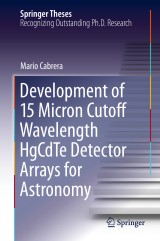Details

Development of 15 Micron Cutoff Wavelength HgCdTe Detector Arrays for Astronomy
Springer Theses
|
96,29 € |
|
| Verlag: | Springer |
| Format: | |
| Veröffentl.: | 17.09.2020 |
| ISBN/EAN: | 9783030542412 |
| Sprache: | englisch |
Dieses eBook enthält ein Wasserzeichen.
Beschreibungen
<p>This thesis describes advances in the understanding of HgCdTe detectors. While long wave (15 μm) infrared detectors HgCdTe detectors have been developed for military use under high background irradiance, these arrays had not previously been developed for astronomical use where the background irradiance is a billion times smaller. The main pitfall in developing such arrays for astronomy is the pixel dark current which plagues long wave HgCdTe. The author details work on the success of shorter wavelength development at Teledyne Imaging Sensors, carefully modeling the dark current–reverse bias voltage curves of their 10 μm devices at a temperature of 30K, as well as the dark current–temperature curves at several reverse biases, including 250 mV. By projecting first to 13 and then 15 μm HgCdTe growth, values of fundamental properties of the material that would minimize tunneling dark currents were determined through careful modeling of the dark current-reverse bias voltage curves, as well as the dark current-temperature curves. This analysis was borne out in the 13 μm parts produced by Teledyne, and then further honed to produce the necessary parameters for the 15 μm growth. The resulting 13 μm arrays are being considered by a number of ground-based astronomy research groups.</p>
Chapter1: Introduction.- Chapter2: Test and Data Acquisition Setup.- Chapter3: Dark Current Theory.- Chapter4: Array Characterization.- Chapter5: Phase I Results: 13 m Cuto Wavelength Devices.- Chapter6: Phase II Results: 15 m Cuto Wavelength Devices.- Chapter7: Conclusions and Future Work.
Mario Cabrera received his PhD from the University of Rochester in 2020.
This thesis describes advances in the understanding of HgCdTe detectors. While long wave (15 μm) infrared detectors HgCdTe detectors have been developed for military use under high background irradiance, these arrays had not previously been developed for astronomical use where the background irradiance is a billion times smaller. The main pitfall in developing such arrays for astronomy is the pixel dark current which plagues long wave HgCdTe. The author details work on the success of shorter wavelength development at Teledyne Imaging Sensors, carefully modeling the dark current–reverse bias voltage curves of their 10 μm devices at a temperature of 30K, as well as the dark current–temperature curves at several reverse biases, including 250 mV. By projecting first to 13 and then 15 μm HgCdTe growth, values of fundamental properties of the material that would minimize tunneling dark currents were determined through careful modeling of the dark current-reverse bias voltage curves, as wellas the dark current-temperature curves. This analysis was borne out in the 13 μm parts produced by Teledyne, and then further honed to produce the necessary parameters for the 15 μm growth. The resulting 13 μm arrays are being considered by a number of ground-based astronomy research groups.
Nominated as an outstanding PhD thesis by the University of Rochester Enhances understanding of quantum tunneling dark currents in detector arrays Describes significant advances in the development of detectors for low-background astronomy

















